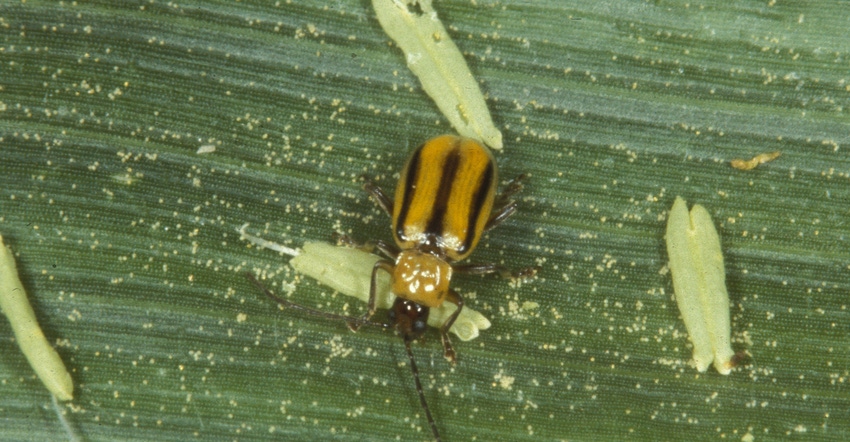
Corn rootworm can be a difficult pest to manage, because with corn-on-corn fields, the beetles need to be monitored the summer before and a management plan needs to be in place — if they reach threshold levels.
With corn following soybeans, the beetles need to be monitored two years before, in the last corn crop on the field. That makes rootworm management a multiyear, ongoing process.
Rob-See-Co direct sales representatives and business associates worked together over the past two years to compile a large CRW beetle-monitoring project in 151 fields across six states, including Nebraska, Kansas, Iowa, North Dakota, Minnesota and Illinois.
In 47 of those fields, two different corn rootworm control strategies were compared, with traps in the remaining fields monitoring rootworm pressure in a single hybrid or corn rootworm control strategy.
Fewer western CRW
The main goal of the study was to demonstrate the impact of Agrisure Duracade for corn rootworm control. Researchers found that there were 14% fewer western CRW beetles in Duracade fields. This was compared to other methods, primarily dual modes of action trait stacks, but also a few single-mode traits and insecticide program fields.
There were no significant differences found in control of northern CRW beetles. While southern CRW beetles often are observed in cornfields, they do not overwinter in central or northern Corn Belt fields, so they are not considered a significant corn pest in those regions tested.
The study also uncovered a few interesting aspects of rootworm beetle pressure that can help corn growers across the Corn Belt. “We used Pherocon AM no-bait sticky traps in the study,” says Wayne Fithian, a Rob-See-Co agronomy manager based in Elkhorn, Neb. “Our goal was to catch the beetles at their peak, so for the three weeks we had the traps set out in the fields. We wanted to see growing populations on the first week, a peak on the second week, and then for the beetles to decline into the third week.”
Traps were set on fields that were irrigated and dryland. In the control method fields, two sets of traps were set, with one set for each control measure. The traps were separated far enough apart to prevent intermingling of beetles between control measures and traps. They also were set a full 48 rows into the field, so researchers could catch what was going on in that part of the field, Fithian says.
Some surprises
There were a few surprises in the results, Fithian says. The western CRW beetle eggs that were laid in 2018 starved in soybeans the following growing season.
“Some came into these fields from other areas, but we saw western CRW beetles on almost all corn-on-corn, especially along the Missouri River and west across Nebraska,” he explains. “We did a pilot study in 2018, and we were surprised this past year with results compared to 2018 and 2019, because we averaged a half-beetle per trap per week in corn following soybeans this year. And they were mostly northern CRW. They are not at threshold levels, but they are approaching threshold levels. So, in 2022, producers will need to watch for CRW in those fields.”
Fithian reminds producers that on corn following soybeans, you have to look back two years to beetle pressure to help decide what to watch for and understand what your risks are.
“Many CRW control measures work,” Fithian says. “Most companies sell their products from efficacy studies that are based on root ratings, yield or both. Through this study, we wanted to broaden the scope of what you get from efficacy comparisons by sampling natural infestations in many different environments, so we would get a better representation on average and help people understand what their risk for CRW is on any given piece of ground.”
Learn more by contacting Fithian at [email protected].
About the Author(s)
You May Also Like






